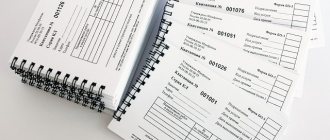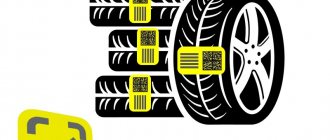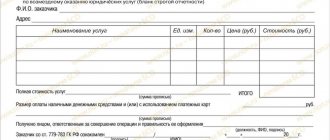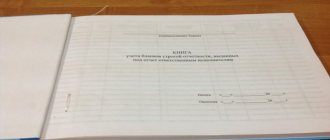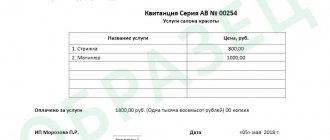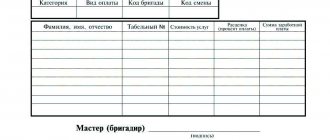Letter No. 16-00-30-33 of the Ministry of Finance of Russia dated April 20, 1995 approved strict reporting forms that were used in the provision of household services by companies of all forms of ownership, and the same letter outlined the procedure for filling them out. For the provision of household services, strict reporting forms from BO-1 to BO-11, including form BO-3, were approved. The number of the specific form of strict reporting that was used in a particular case was determined by the specifics of the provision of the service and the Rules for the provision of household services in the Russian Federation.
It is worth noting that the BSO forms, which were approved before the entry into force of Decree of the Government of the Russian Federation dated May 31, 2005 No. 171, were used until December 1, 2008. However, this does not mean that it is absolutely impossible to use these forms in your work: you can use the forms in your activities on a voluntary basis until 07/01/2018, if they contain all the necessary details.
Strict reporting form BO-3
Thus, according to Decree of the Government of the Russian Federation dated May 6, 2008 No. 359, the strict reporting form must contain the following details:
- name of the document, its number (consists of 6 characters) and series;
- for companies - name and form of ownership; for entrepreneurs, the full name (full name) is indicated;
- the place where the permanent executive body of a legal entity is located, for example, the general director or another person who has the right to represent the company - to act on its behalf without a special power of attorney;
- taxpayer identification number assigned to the company or individual entrepreneur issuing the BSO;
- type of service provided according to the executed document;
- the cost that the client must pay for the service provided in monetary terms;
- the amount (value) of the actual payment, which was transferred in the form of cash or transferred from a credit card;
- the date when the calculation was made and the document was drawn up;
- the form, including form BO-3, contains the position, full name (full name) of the person who is responsible for the transaction and its correct execution, personal signature, seal of the company or individual entrepreneur;
- other details necessary to characterize the service provided and which the organization or individual entrepreneur has the right to include in the document.
Document forms for work are printed in a printing house or generated using special programs. In addition, the document form produced in the printing house must contain not only information related to the service provided and its cost, but also information about who produced the document form (abbreviated name of the printing house, TIN, place where it is located, order number for BSO and year when it was completed, circulation of printed forms).
According to the letter from the Ministry of Finance, which approved the BO-3 form, the document is intended for placing orders in photo salons, laundry, rental of various items, as well as various repairs that do not require the cost of materials. The form must be issued by the employee receiving the item in three carbon copies. The first copy is used to accompany the order while it is in progress, and is also used for payroll. The second copy must be issued to the customer of the service. After the service is completed, the customer must return the receipt. If the result of the service provided does not meet the customer’s expectations, then he tears off a special coupon from it. A third copy of the completed form is required to account for the cash proceeds received.
Form BO-3, sample filling
You can download form BO-3 here.
>Standard BSO forms
TYPICAL FORM: BO-3
Replacing a cash register receipt
In accordance with the legislation of the Russian Federation, there is an exception for organizations and individual entrepreneurs that provide services to the public - they can replace the check and cash register with a strict reporting form.
The legislation of the Russian Federation provides for the issuance of a cash or sales receipt. An authorized person who receives funds as payment for services must issue the client either a cash receipt or a sales receipt.
An enterprise that issues a BSO instead of a check must ensure the correct content of the document and its compliance with the legislation of the Russian Federation.
Replacement of a check can be carried out when settlements with the population occur using cash (when working with legal entities, you cannot replace a check with BSO), when services are provided rather than sold, if the activity is carried out according to the chosen form - UTII or patent.
Standard form BO-3
Form BO-3 is not mandatory for use. Each organization or individual entrepreneur that uses strict reporting forms must develop its own BSO for its work. But, of course, you can take the old BO-3 form as a basis, simplifying it and adapting it to your needs.
The original form consisted of three parts - “Work Order”, “Receipt”, “Copy of Receipt”. A table for calculating wages is printed on the reverse side of the Work Order.
- Form BO-3 was used when performing the following work:
- photographic works;
- laundry (self-service);
- single (incomplete) funeral services;
- rental of items for hourly use;
- all types of repair work that do not require materials.
The form is written out by the person placing the order in triplicate.
Work order (form code according to OKUD 0790006) - the first copy of the form - is transferred to production to accompany the order and pay wages to the contractor.
A receipt (form code according to OKUD 0790005) - the second copy - is issued to the customer, remains with him after the service is completed and confirms its completion.
A copy of the receipt (form code according to OKUD 0790005) - the third copy - is used to record cash proceeds.
When filling out this form, a note is made on the back of the first and second copies indicating the issuance of the completed order, which must be confirmed by the customer’s signature. In addition, the warranty period for the result of the work performed is indicated. If the work is completed unsatisfactorily, a special coupon is torn from the second copy. This form can also be used when fulfilling an order involves a large quantity and volume of work, components and products, and a large number of complicating elements. In this case, an agreement must be concluded to complete the order or a technological document must be drawn up, which details the work and materials. In this case, in the BO-3 form only the total cost of the order will be indicated without decoding. In the form it is also necessary to make a reference to the number of the contract or technical document, and in the contract or document, accordingly, to make a reference to the number of the form.
12 BSO samples found: 40
Topic: BO-3, What is the tax office interested in?
Approved by Decree of the Government of the Russian Federation of March 31, 2005 N 171 Regulations on cash settlements and (or) settlements using payment cards without the application of cash registers 1. This Regulation establishes the procedure for the implementation by organizations and individual entrepreneurs of cash settlements and ( or) settlements using payment cards without the use of cash register equipment in the case of providing services to the population, subject to the issuance of appropriate strict reporting forms, equivalent to cash receipts, as well as the procedure for approval, accounting, storage and destruction of the forms. 2. Strict reporting forms, equivalent to cash receipts, include receipts, tickets, travel documents, coupons, vouchers, subscriptions and other documents intended for making cash payments and (or) payments using payment cards in the case of providing services to the public ( below - forms). 3. Forms of forms are approved by the Ministry of Finance of the Russian Federation at the request of interested government bodies, the Central Bank of the Russian Federation and organizations uniting business entities engaged in a certain service sector. The following are attached to the application: a) description of the form (mandatory and additional details characterizing the specifics of the activities of the organization or individual entrepreneur); b) a sketch of the form (its artistic and graphic design); c) a proposal to ensure the protection of the form from counterfeiting; d) instructions for filling out the form; e) recommendations for using the form, as well as a list of services that are supposed to be provided using the form. 4. When filling out the form, it must be ensured that at least 1 copy is made at the same time (using carbon or self-copying paper) or the form must have tear-off parts. For public ground passenger transport, the use of a rolled form of the form is allowed. 5. The form (except for the forms specified in paragraph 6 of these Regulations) must contain the following mandatory details: a) information about the approval of the form form; b) name, six-digit number and series; c) code of the form according to the All-Russian Classifier of Management Documentation; d) name and code of the organization or individual entrepreneur that issued the form, according to the All-Russian Classifier of Enterprises and Organizations; e) taxpayer identification number; f) type of services; g) unit of measurement for the provision of services; h) the cost of the service in monetary terms, including the amount of payment made in cash or using a payment card; i) date of settlement; j) the name of the position, surname, name and patronymic of the person responsible for the transaction and the correctness of its execution, a place for a personal signature, seal (stamp) of the organization or individual entrepreneur. 6. The form intended for making cash payments for travel by public ground passenger transport must contain the following mandatory details: a) name, six-digit number and series; b) code of the form according to the All-Russian Classifier of Management Documentation; c) the name of the organization or individual entrepreneur that issued the form; d) the type of vehicle on which the passenger transportation service is provided; e) the cost of the service in monetary terms. 7. The form must contain information about the manufacturer (abbreviated name, taxpayer identification number, location, order number and year of execution, circulation). 8. If filling out a particular line of the form is impossible due to the lack of appropriate indicators in the organization or individual entrepreneur, a dash is placed in the line. 9. When preparing the form, it is allowed to make changes to it regarding the expansion (narrowing) of the columns, taking into account the details. 10. The affixing of the series and number on the form is carried out by the manufacturer of the forms. Duplicating the series and number on the forms is not allowed, with the exception of the series and number applied to the copies for registration of the form in accordance with paragraph 4 of these Regulations. 11. Forms of forms approved in accordance with these Regulations can be used by all organizations and individual entrepreneurs providing services to the population of the types for which these forms were approved. 12. Forms of forms are approved for a period established by the Ministry of Finance of the Russian Federation. An extension of the validity period of the form can be made at the request of the interested government body, the Central Bank of the Russian Federation and an organization uniting business entities engaged in a certain service sector, provided that the specified form complies with the requirements in force at the time of filing such an application. 13. Documents drawn up on forms are primary accounting documents (except for the forms specified in paragraph 6 of these Regulations). 14. Organizations and individual entrepreneurs keep records of forms. 15. Forms must be filled out clearly and legibly, using carbon or self-copying paper or without it, if copies are not provided. Erasures, amendments and corrections on the form are not allowed. Damaged or incorrectly filled out forms are not destroyed, but are crossed out and attached to the cash report (statement, register) for the day on which they were issued. 16. Accounting of forms by their names, series and numbers is maintained in the book for accounting forms. The sheets of such a book must be numbered, laced and signed by the head and chief accountant (accountant) of the organization or individual entrepreneur, and also sealed (stamp). 17. The head of an organization or an individual entrepreneur enters into an agreement with the employee who is entrusted with receiving, storing and issuing forms, as well as accepting cash from the population in accordance with the executed forms, in accordance with the legislation of the Russian Federation. The head of the organization or individual entrepreneur creates conditions for the specified employee to ensure the safety of the forms. 18. Forms are accepted by the employee specified in paragraph 17 of these Regulations in the presence of a commission appointed by the head of the organization or an individual entrepreneur. Acceptance is made on the day the forms are received. The commission checks the compliance of the actual quantity, series and numbers of forms with the data specified in the accompanying documents (invoices, receipts, etc.) and draws up an acceptance certificate for the forms. This act, approved by the head of the organization or individual entrepreneur, is the basis for the acceptance of registration forms by the specified employee. 19. Forms are stored in metal cabinets and (or) safes. In an organization or individual entrepreneur that receives forms in large quantities, it is allowed to store them in specially equipped premises under conditions that prevent damage and theft of forms. At the end of the working day, the storage areas for forms are sealed or sealed. 20. The inventory of forms is carried out simultaneously with the inventory of cash and cash documents in the cash desk. 21. When monitoring the proper use of forms, the presence of used receipt books (other bound forms) on the covers (sheets pasted on the books), the seal of the organization or individual entrepreneur and the signature of the chief accountant (accountant), the safety of copies of the forms (spines), the absence of erasures and corrections, as well as the correspondence of the amounts indicated in the copies (counterfoils) with the amounts reflected in the statements and registers submitted to the accounting department, or in cash reports. 22. Assigning responsibilities for monitoring the use of forms to persons issuing forms is not permitted (with the exception of organizations or individual entrepreneurs, where the responsibilities of the responsible person are combined in one person with the chief accountant or head of the organization or individual entrepreneur). 23. Copies of used forms (stubs) confirming the amounts of cash accepted (and using payment cards) packed in sealed bags are stored in an organization or individual entrepreneur in a systematic manner for at least 5 years. At the end of the established storage period, but necessarily after the expiration of a month from the date of the last inventory and verification of the product report, copies of used forms (stubs) are destroyed on the basis of an act on their write-off, drawn up by a commission formed by the head of the organization or an individual entrepreneur. Incomplete or damaged forms are destroyed in the same manner. 24. Organizations and individual entrepreneurs providing services to the population for which the appropriate forms have not been approved use cash register equipment when making cash payments and (or) payments using payment cards. 25. In the case of using forms, cash payments and (or) payments using payment cards are carried out in the following order: a) when paying for services in cash, organizations and individual entrepreneurs: fill out the form, with the exception of the space for signature (except for the form intended for carrying out the specified payments for travel by public ground passenger transport); receive funds from the client; name the amount of funds received and place them separately in full view of the client; sign the form (except for the form intended for making specified payments for travel by public ground passenger transport); They call the change amount and give it to the client along with the form. In this case, paper bills and small change coins are issued simultaneously; b) when paying for services using a payment card, organizations and individual entrepreneurs: receive a payment card from the client; fill out the form, except for the space for signature; insert the payment card into the payment card reader and receive confirmation of payment on the payment card; sign the form; return the payment card to the client along with a form and document confirming the transaction using the payment card. 26. Mixed payment is allowed, in which one part of the service is paid in cash, the other - using a payment card, in accordance with paragraph 25 of these Regulations. In this case, the issuance of the form, delivery and return of the payment card must be carried out simultaneously.
BSO for individual entrepreneurs, LLCs, beauty salons and hairdressing services
Concept and forms
The strict reporting form can be issued to both individuals and individual entrepreneurs, who, in accordance with the law, are equated as consumers to citizens.
If the company is a legal entity, then this document cannot be issued to it - non-cash payments are made with them. OKUN is a classifier of services for the population, which contains their list and full name. It is of a nationwide nature.
BSO includes receipts of various types, subscriptions, transport tickets, orders issued by the enterprise, coupons.
Forms approved at the legislative level, the use of which is mandatory:
- To provide parking services - approved by the Ministry of Transport.
- Forms with the names “Ticket”, “Subscription” and “Excursion package” - from the Ministry of Culture.
- For payment - in accordance with the Order of the Ministry of Finance of the Russian Federation.
- Pawnshops use the “Safety Receipt” and “Deposit Ticket”, which were approved by the Ministry of Finance of the Russian Federation.
- The “Tourist voucher” form, which was approved by Order No. 60n dated 07/09/2007.
- BSO for various types of transport tickets and baggage receipts.
In accordance with the new rules of the legislation of the Russian Federation, by July 1, 2018, all organizations and individual entrepreneurs switched to the new approved BSO.
BSO for individual entrepreneurs, LLCs, beauty salons and hairdressing services in the BO-3 form
The BO-3 form is a very universal strict reporting form. It is used by individual entrepreneurs of various LLCs in various fields of activity providing household services to the population: beauty salon, hairdressing services, rental and much, much more.
BO-3 is drawn up by the receiver in 3 carbon copies.
The first copy (work order) is sent with the application and is used for payroll. 2nd copy (receipt) is issued to the client. After completing the offer, the client returns the receipt and, in case of unsatisfactory fulfillment of the order, leaves a tear-off coupon. The 3rd copy (copy of the receipt) is used to account for funds.
You can read about the use of BSO forms in 2021 for individual entrepreneurs and LLCs when providing household services to the population in the corresponding section of our website - BSO in 2021
Features of the new BSO
Federal Law No. 290 introduced many changes to the previous procedure for working with the document. The mandatory rules will come into force in 2021 from July 1. In view of changes of this kind, transformations will also affect the content of the document and its design. The document must contain certain information:
- Who provides the services: name of the enterprise (its tax identification number, address), information about the chosen taxation system, the shift in which the document is issued, full name of the responsible authorized person carrying out the procedure.
- About the nature of the payment being made - the name and number assigned for the shift, the characteristics of the payment - a return transaction or a sales operation, the name of the service provided, the volume of the service, the price for 1 unit. and the total amount to be paid including VAT, as well as the method of depositing funds (cash and non-cash).
- Fiscal type information. Here the serial and registration number of the device, the fiscal type sign, the identification number of the fiscal information, the transfer code, the address and name of the OFD operator, as well as the QR type code combination are indicated.
The main innovation will be the technical introduction of fiscal accounting into the activities of organizations. The device intended for issuing such documentation consists of a drive (fiscal type), a print head and a module for Internet access. It is subject to mandatory registration with the Federal Tax Service.
The drive requires regular, systematic replacement, and the new element requires registration with the tax authority. This can also be done online without a personal visit. To transfer data, an enterprise must enter into an agreement with the OFD operator.
Uploading the document “Receipt. Form N BO-3"
Home / Samples / Miscellaneous / Receipt. Form N BO-3 /
| Wait: | 19 | sec |
Document file name: 43158
Available download formats: .doc, .pdf
Text file size: 2.9 kb
Agreement-example.ru is a database of more than 5 thousand standard samples of contracts and documents, daily updates and a large community uniting legal experts. The site contains a wide variety of agreements, contracts, agreements, statements, acts, accounting and financial documents, questionnaires, powers of attorney and many other samples that may be required in the life of every person. Thank you for your participation. Please note that the sample document presented is a typical document, it reflects the essential conditions, but does not take into account the specific situation. If you need an individual document for you, it is better to contact qualified specialists. Documents that may also interest you:
- Receipt. Form N BO-4
- Receipt. Form N BO-5
- Receipt. Form N BO-10 DM
- Receipt. Form N BO-12
- Receipt. Form N BO-13 (01)
- Receipt. Form N BO-14 auto service
- Receipt. Form N 47
- Classifier of types of transactions with cash currency and checks
- Classifier of solutions for expert assessment of personnel (list of indicators and criteria)
- Classifier of delivery conditions (to the barter transaction passport)
- Classifier of payment forms for foreign trade barter transactions (to the barter transaction passport)
- Classification groups of activities of credit institutions and information about information not contained in the reporting used to classify credit institutions, but taken into account by the territorial branches of the Bank of Russia when making decisions on assessing the financial condition of credit institutions. Form N 050
- Classification of commercial freight car faults
- Clinical forms of diphtheria
- Book of preferential trade services in the Noginsk district of the Moscow region
Form BO-3
Use code MB37 to reference this sample.
Strict reporting forms BO-3 are not necessary for doing business, but they significantly simplify the hassle with statements and compliance with orders. Each enterprise has the right to create its own formulations and variations of the BSO. Form BO-3 was often used to comply with such services as:
- Services of a photographer, makeup artist, cosmetologist;
- Self-service in laundries, dry cleaners;
- Hourly or daily rental of things (for example: in the theater);
- Small repair orders without special costs (household appliances).
Just like other forms, this one is issued in triplicate:
- Outfit order;
- Receipt;
- A copy of the receipt.
The first option is used to transfer an order for execution, monitoring and marking, as well as charging payment to the contractor. The second one is received by the customer and confirms that his item was transferred for repair or that work was performed for him. In addition, our company offers BO-10 forms. A copy of the receipt is used to control and track funds by the customer. At the final stage, on the back side of the order and receipt, a special note is created indicating the completion of the provision of services and the fulfillment of the specified conditions. Both notes about the rules must be signed by the client. If he is dissatisfied with the quality of the services provided, he tears off the warranty card from the second option and uses all its capabilities. In case of failure to complete the work, a separate special document must be drawn up detailing the work performed and the materials spent on it. The form contains a link to its number. In the BO-3 form, the cost of work or services provided is provided only as a total cost, without additional decoding. The Contractor has the right not to report materials or funds in all details when filling out a statement according to this standard.
Requirements for registration of BSO
By registering a BSO, a business entity (seller) has the right to confirm the fact of receiving funds from an individual (buyer).
It is noteworthy that in this case the buyer can pay either in cash or with a bank card. Accordingly, the seller can receive the funds paid either in cash or in non-cash form.
The requirement for strict accounting of all SSO documents is of particular importance. This indicates the need to comply with certain rules by the person drawing up and taking into account strict reporting documents when receiving money from the buyer.
The strict reporting form is considered an official payment document; its legal force fully corresponds to a cash (fiscal) check.
A typical example of a BSO can be considered a transport ticket. This document officially certifies the fact of provision of transport services to the passenger. The issuance and presentation of a travel ticket confirms payment for the service provided.
